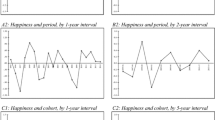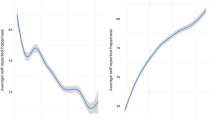Abstract
In social economic data analysis, sometimes the explanatory variables that are statistically significant in OLS regressions in cross-section or pooled data become insignificant after controlling for individual fixed effects. This phenomenon was observed in the study of the relationship between age and happiness. The discrepancy in estimates between regressions with and without controlling for individual fixed effects was known as the age-happiness mystery. This paper points out that OLS regressions based on cross-section data reflect the difference in average happiness across birth cohorts. In contrast, regressions controlling for individual fixed effects reflect the change in happiness over life cycle within individuals. For the first time in the literature, the co-existence of a cross-section U shape and a longitudinally declining pattern in the relationship between age and happiness is established. Using data from the Household, Income and Labour Dynamics in Australia (HILDA) Survey, this paper explains the exact meaning of fixed-effects regressions of happiness on age, gives insight into the age-happiness puzzle, and raises the awareness of multidimensionality of longitudinal data.






Similar content being viewed by others
Notes
See the recent paper by López Ulloa et al. (2013) for a comprehensive review of the theoretical framework and empirical evidence on age-happiness research.
These studies tried to control for individual fixed effects using methods different from the FE regression.
An early version of the paper appeared in NCER Working Paper Series, Working Paper #26, 2008.
See also López Ulloa et al (2013, p.239).
Numerical results and graphs in the paper can be reproduced using the program codes in the Supplementary Material.
See Summerfield et al. (2013) for detailed information about the HILDA data.
Ferrer-i-Carbonell and Frijters (2004) have shown that ordinality or cardinality makes little difference to the final results in analysing happiness scores.
For space constrain, the numerical results are not displayed in the paper. But they can be reproduced using the supplied programs.
Lines between 391 and 440 in the Stata code show the calculation.
This procedure is sometimes called regression under the matched data design.
Why happiness is U-shaped in age across cohorts in a given year or negatively related to ageing over time is not the concern of this work.
References
Berg, A. I., Hoffmanb, L., Hassinga, L., McClearnc, G., & Johanssona, B. (2009). What matters, and what matters most, for change in life satisfaction in the oldest-old? a study over 6 Years among individuals 80+. Ageing and Mental Health, 13(2), 191–201.
Blanchflower, D., & Oswald, A. J. (2008). Is well-being U-shaped over the life cycle? Social Science and Medicine, 66, 1733–1749.
Blanchflower, D.G. & Oswald, A.J. (2009). The U-shape without controls. Warwick economic research papers, No. 896, Department of Economics, The University of Warwick.
Carstensen, L. L., Pasupathi, M., Mayr, U., & Nesselroade, J. R. (2000). Emotional experience in everyday life across the adult life span. Journal of Personality and Social Psychology, 79(4), 644–655.
Charles, S. T., Reynolds, C. A., & Gatz, M. (2001). Age-related differences and change in positive and negative affect over 23 Years. Journal of Personality and Social Psychology, 80, 136–151.
Chen, C. (2001). Ageing and life satisfaction. Social Indicators Research, 54(1), 57–79.
Cheng, T. C., Powdthavee, N. & Oswald, A. J. (2014). Longitudinal evidence for a midlife nadir in human well-being: Results from four data sets. IZA discussion paper no. 7942.
Clark, A. E. (2007). Born to be mild? Cohort effects don’t (Fully) explain why well-being is U-shaped in age. IZA discussion papers no. 3170.
Clark, A. E., & Oswald, A. J. (2006). The curved relationship between subjective well-being and age. PARIS-Jourdan Sciences Economiques, working paper no. 29.
Costa, P. T, Jr, Zonderman, A. B., McCrae, R. R., Cornoni-Huntley, J., Locke, B. Z., & Barbano, H. E. (1987). Longitudinal analyses of psychological well-being in a national sample: Stability of mean levels. Journal of Gerontology, 42, 50–55.
Cummins, R. A., Li, N., Wooden, M., & Stokes, M. (2013). A demonstration of set-points for subjective wellbeing. Journal of Happiness Studies, 15(1), 183–206.
Diener, E., Suh, E. M., Lucas, R. E., & Smith, H. L. (1999). Subjective well-being: Three decades of progress. Psychological Bulletin, 125, 302–376.
Easterlin, R. A. (2003). Explaining happiness. Proceedings of the National Academy of Sciences of the United States of America (PNAS), 100(19), 11176–11183.
Ferrer-i-Carbonell, A., & Frijters, P. (2004). How important is methodology for the estimates of the determinants of happiness? The Economic Journal, 114(July), 641–659.
Fischer, J. A. V. (2009). Happiness and age cycles—Return to start. Munich Personal RePEc Archive (MPRA), paper no. 15249.
Frijters, P., & Beatton, T. (2012). The mystery of the U-shaped relationship between happiness and age. Journal of Economic Behavior and Organization, 82, 525–542.
Gerlach, K., & Stephan, G. (1996). A paper on unhappiness and unemployment in Germany. Economics Letters, 52, 325–330.
Glenn, N. (2009). Is the apparent U-shape of well-being over the life course a result of inappropriate use of control variables? A commentary on Blanchflower and Oswald (66: 8, 2008, 1733–1749). Social Science and Medicine, 69, 481–485.
Goldbeck, L., Schmitz, T. G., Besier, T., Herschbach, P., & Henrich, G. (2007). Life satisfaction decreases during adolescence. Quality of Life Research, 16(6), 969–979.
Gwozdz, W., & Sousa-Poza, A. (2010). Ageing, health and life satisfaction of the oldest old: An analysis for Germany. Social Indicator Research, 97, 397–417.
Kassenboehmera, S. C., & Haisken-DeNew, J. P. (2012). Heresy or enlightenment? The well-being age U-shape effect is flat. Economics Letters, 117, 235–238.
Kristoffersen, I. (2013). The Age‐Happiness Puzzle: The role of economic circumstances and financial satisfaction. In HILDA survey research conference 2013—Papers, June 15 2015. http://www.melbourneinstitute.com/downloads/conferences/HILDA_2013/HILDA_2013_papers/Kristoffersen,%20Inga_final%20paper.pdf.
Kunzmann, U., Little, T. D., & Smith, J. (2000). Is age-related stability of subjective well-being a paradox? Cross-sectional and longitudinal evidence from the Berlin ageing study. Psychology and Ageing, 15(3), 511–526.
Lacey, H. P., Kierstead, T. A., & Morey, D. (2012). De-biasing the age-happiness bias: Memory search and cultural expectations in happiness judgments across the lifespan. Journal of Happiness Studies, 13, 647–658.
Lang, F. R., & Heckhausen, J. (2001). Perceived control over development and subjective well-being: Differential benefits across adulthood. Journal of Personality and Social Psychology, 81, 509–523.
López Ulloa, B. F., Møller, V., & Sousa-Poza, A. (2013). How does subjective well-being evolve with age? A literature review. Population Ageing, 6, 227–246.
Mroczek, D. K., & Kolarz, C. M. (1998). The effect of age on positive and negative affect: A developmental perspective on happiness. Journal of Personality and Social Psychology, 75(5), 1333–1349.
Mroczek, D. K., & Spiro, A, I. I. I. (2005). Change in life satisfaction during adulthood: Findings from the veterans affairs normative ageing study. Journal of Personality and Social Psychology, 88(1), 189–202.
Myers, D. G. (2000). The funds, friends, and faith of happy people. American Psychologist, 55(1), 56–67.
Ree, J. D., & Alessie, R. (2011). Life satisfaction and age: Dealing with under-identification in Age-Period-Cohort Models. Social Science and Medicine, 73, 177–182.
Summerfield, M., Freidin, S., Hahn, M., Ittak, P., Li, N., Macalalad, N., et al. (2013). HILDA user manual - release 12. Melbourne: Melbourne Institute of Applied Economic and Social Research.
Van Landeghem, B. G. M. (2008). Human well-being over the life cycle: Longitudinal evidence from a 20-year panel. LICOS discussion paper no. 213.
Wooden, M., & Li, N. (2014). Panel conditioning and subjective wellbeing. Social Indicators Research, 117, 235–255.
Wunder, C., Wiencierz, A., Schwarze, J., & Küchenhoff, H. (2013). Well-Being over the life span: Semiparametric evidence from British and German longitudinal data. The Review of Economics and Statistics, 95(1), 154–167.
Acknowledgments
This paper uses unit record data from the Household, Income and Labour Dynamics in Australia (HILDA) Survey. The HILDA Project was initiated and is funded by the Australian Government Department of Social Services (DSS) and is managed by the Melbourne Institute of Applied Economic and Social Research (Melbourne Institute). The findings and views reported in this paper, however, are those of the author and should not be attributed to either DSS or the Melbourne Institute. The author thanks Jongsay Yong for a suggestion that has improved the presentation of the first draft, and thanks Andrew Oswald and Nick Powdthavee for comments and discussions. The author is grateful for the challenging comments from the anonymous reviewers that have provided an opportunity to further clarify the work.
Author information
Authors and Affiliations
Corresponding author
Electronic supplementary material
Below is the link to the electronic supplementary material.
Rights and permissions
About this article
Cite this article
Li, N. Multidimensionality of Longitudinal Data: Unlocking the Age-Happiness Puzzle. Soc Indic Res 128, 305–320 (2016). https://doi.org/10.1007/s11205-015-1032-4
Accepted:
Published:
Issue Date:
DOI: https://doi.org/10.1007/s11205-015-1032-4




